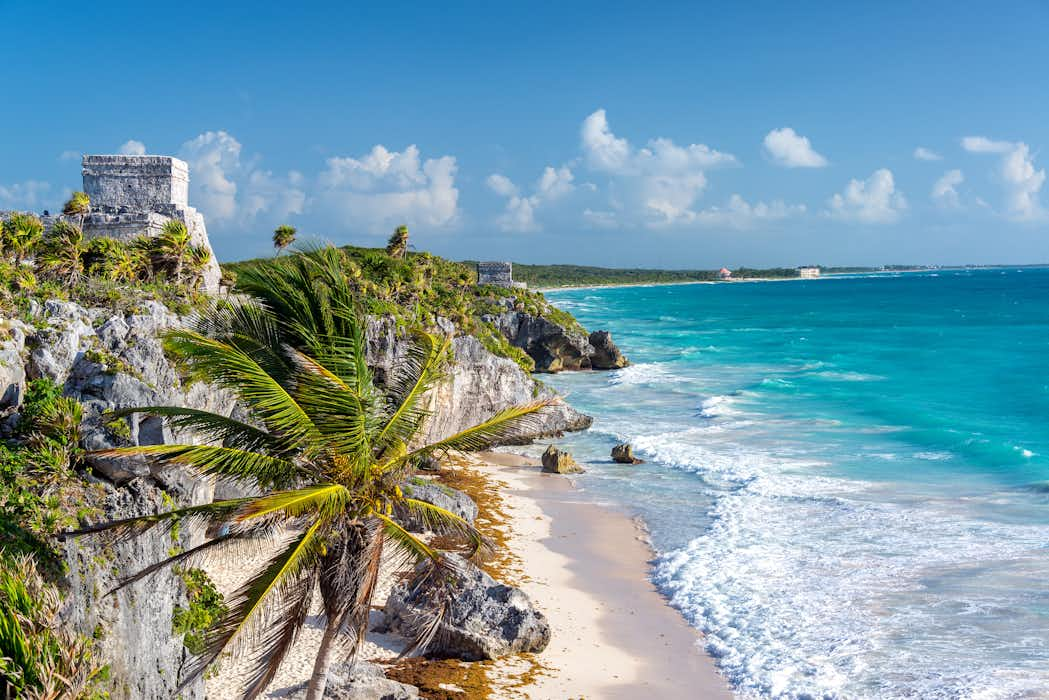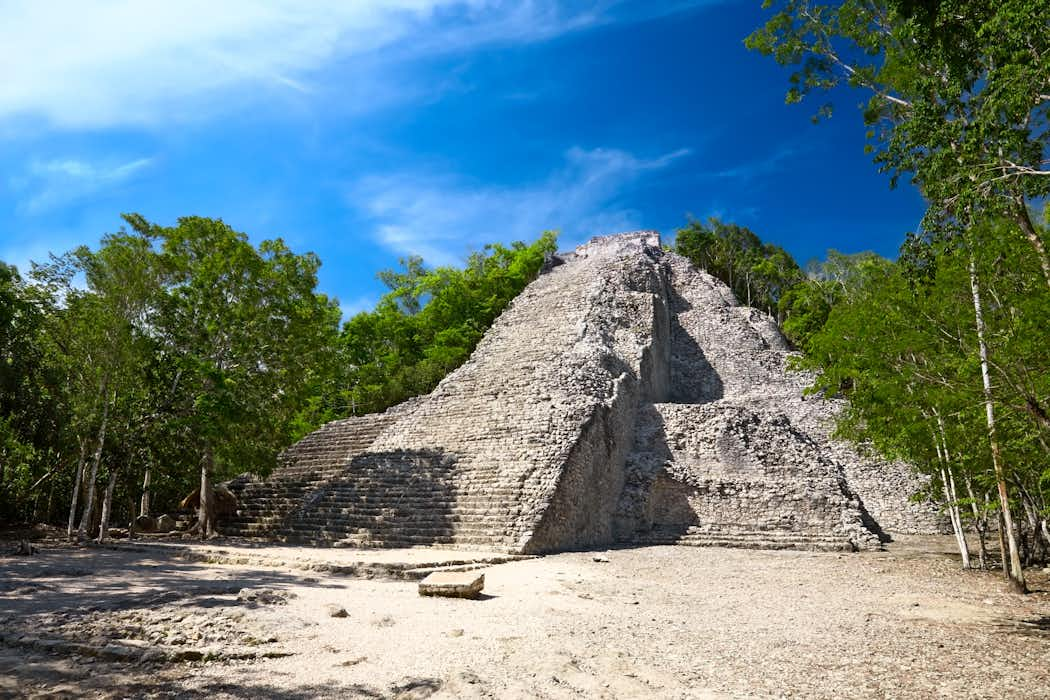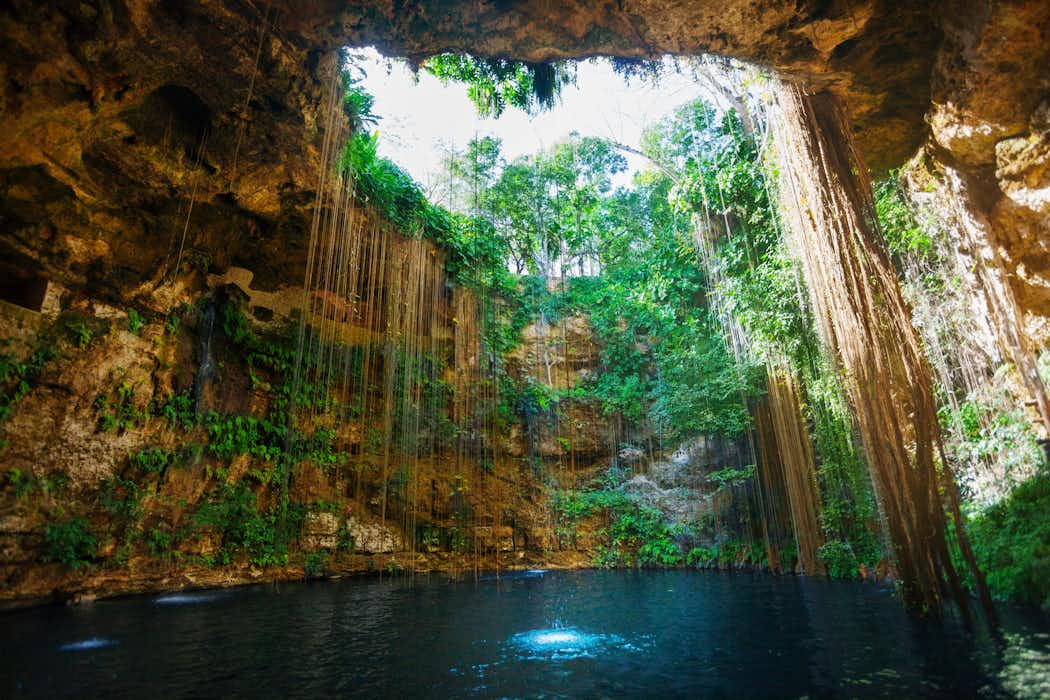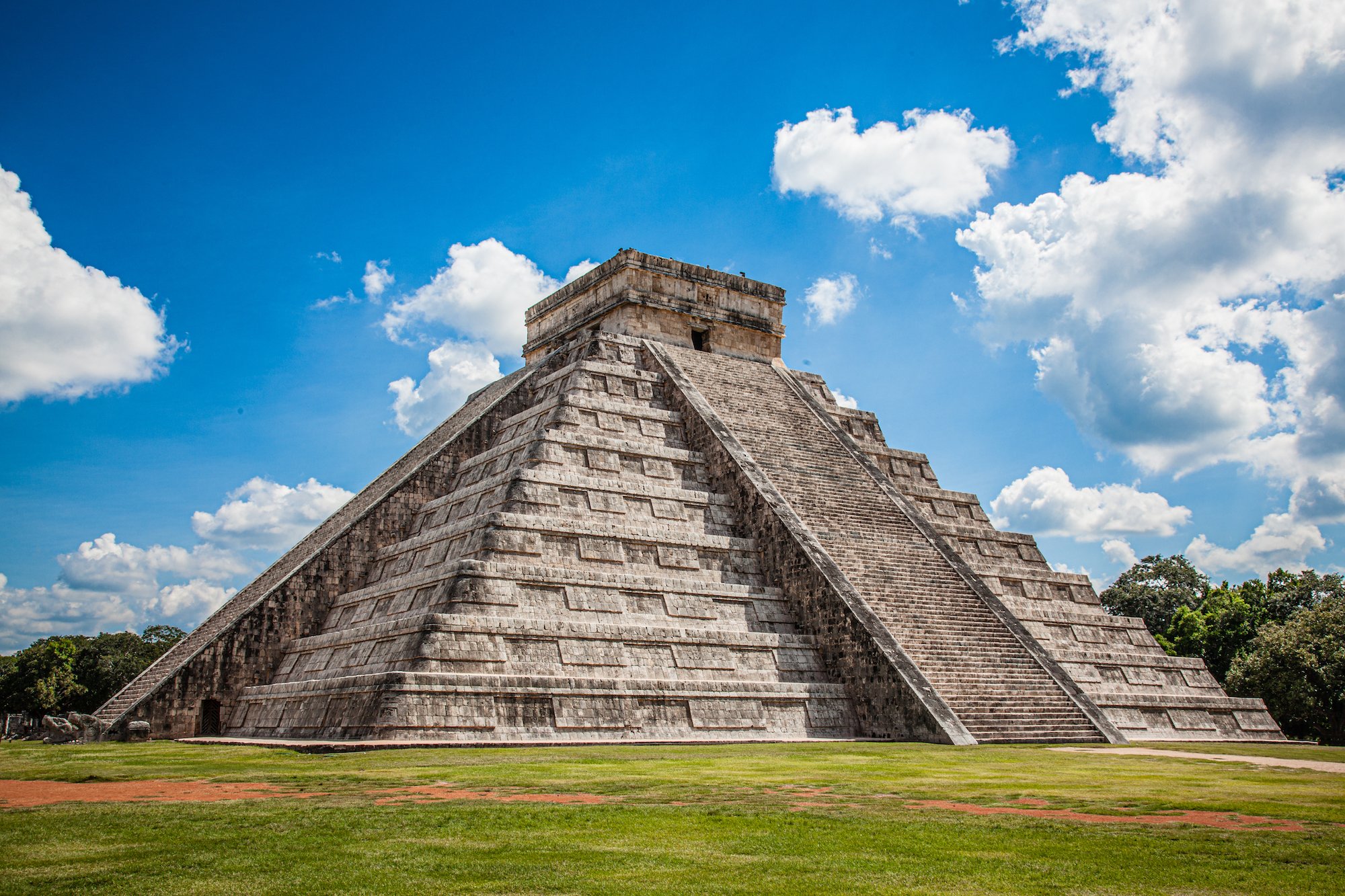Yucatan Peninsula Ruins (2023 Guide)
Stunning Chichén Itzá, Yucatán, Mexico
The Yucatan Peninsula is best known for two things: stunning beaches and amazing Mayan ruins. If you need a break from the sand and sea, exploring Mayan ruins offers a deeper understanding of Mexican history. And for natural beauty and cultural significance, there are the famous "cenotes".
On this Yucatan Peninsula Ruins tour, we'll take you to the most popular ancient cities for a look into the life of this pre-Hispanic civilization.The Mayans worshipped these "sacred wells", and today, these natural sinkholes are refreshing natural swimming holes. Visiting a cenote is a must-do on any Yucatan vacation, and on this tour, you'll be able to visit one of the country’s most popular. Cancun is without doubt the most popular location on the Yucatan Peninsula. Offering convenient international connections at Cancun Airport, it’s a great starting point for your Yucatan Peninsula Ruins tour.
Here’s your Yucatan Peninsula Ruins itinerary:
Day 1: Cancun - Tulum
Day 2: Tulum - Valladolid
Day 3: Valladolid - Merida
Day 4: Merida - Campeche
Day 5: Campeche - Calakmul
Day 1: Cancun to Tulum
Once you’ve spent some time in tourist hot spot Cancun, we’ll take you to its equally popular, but slightly less touristic counterpart; the Mayan city of Tulum. We’ve picked a short route for you on Day 1 of your Daytrip itinerary to give you plenty of time to enjoy all Tulum has to offer. First, we will take you to two great attractions before you reach your destination.
El Rey Ruins

For your first taste of Mayan culture, you don't even have to leave Cancun’s Hotel Zone. The El Rey Ruins date from the 14th and 16th centuries as part of the Mayan Trade route. While no one knows what the Mayan name for the settlement was, the remains of a noble, or possibly even king were uncovered here, earning it the nickname "El Rey". Take an hour to explore the two temples and other structures, all of which are now part of an iguana kingdom.
Two Eyes Cenote
Stunning Two Eyes Cenote
The Two Eyes Cenote is one of the most popular cenotes in all of Mexico. Stop for 75 minutes to experience the two sinkholes. They're connected by a subterranean passageway, which is itself part of one of the longest underwater cave systems in the world. One of the pools is dark and cavernous, and in contrast the second is surrounded by trees and natural vegetation through which the light blazes, illuminating the water which shines a bright turquoise-blue. Snorkeling and diving are popular here, but swimming and simply spectating can also be enjoyed.
Arrival in Tulum

Tulum is equal parts a beautiful, relaxing beach town and a cultural, historically significant center. There’s no doubt that the long stretches of white sand beaches and the sparkling blue waters are some of the best in Mexico. Still less trodden than neighboring Cancun and Playa del Carmen, Tulum is popular for its laid-back charm in tranquil surroundings. Founded in the 13th century by the Mayans as a fortified port, it was one of the last cities the empire built before its collapse. Thanks to its strategic location it played an important part in the Maya’s extensive trade network, connecting maritime and land routes in a place where land meets sea.
Literally meaning “wall” in ancient Yucatec language, Tulum offers a unique opportunity to see the only Mayan settlement built on the Caribbean beaches. The Tulum ruins are walled to the east, and to the west, face the glorious Caribbean sea. They sit atop a cliff on the edge of the ocean and the views are nothing short of spectacular. Though you cannot enter the temples and the ruins attract a lot of tourists, they’re not to be missed if only for the views.
After exploring the ancient ruins you can dive, snorkel or swim in the lush ocean or partake in one of many other water sports on offer. Tulum is packed with bars and restaurants for when you’re ready to unwind in the evening, with plenty of cocktails and dancing on offer too.
Duration: 4 hours and 48 minutes
Book a car from Cancun to Tulum
Day 2: Tulum to Valladolid
From a picturesque coastal city to a hidden jungle gem inland, today you’ll travel from Tulum to Valladolid via popular Coba and Ek Balam ruins.
Coba

Though it's now surrounded by dense jungle, at its peak around 900 AD, Coba covered 80 km² and was home to an estimated 50,000 inhabitants. The Mayan version of Rome, it had the largest network of highways radiating from its central pyramid. Spend two hours exploring the archaeological site, and be sure to climb to the top of the Ixmoja pyramid (the tallest in Northern Yucatan at 42 meters high!). The 120 steep, stone steps are a workout, but the views across the whole archaeological site are worth it.
Ek Balam

Another Mayan surrounded by jungle, Ek Balam boasts some of the most intricate Mayan ornamentation in the Yucatan. The archaeological site spans several temples, a large pyramid, and two palaces. But the highlight of your 90-minute-visit will undoubtedly be the king's tomb with stylized jaguar-mouth as its entrance (Ek Balam actually means “Black Jaguar” in ancient Mayan language).
Arrival in Valladolid
Located in Yucatan state and known for its beautiful natural landscape, Valladolid was once the capital of the Maya East. It is surrounded by thousands of natural cenotes, plenty of historic sites, and an exciting gastronomy scene that is helping it gain popularity. The rural city in the middle of the Yucatan jungle is a great example of ‘authentic’ Mexico. It's slightly off the beaten path and dripping in history and culture that is still largely undiscovered by international visitors.
From exploring the pretty pastel buildings that line Calzada de los Frailes, to marveling at Mexican history at Casa de los Venados, a private home museum, there is something for everyone in Valladolid. The central square, Parque Francisco Canton Rosado, is the bustling heart of the city. Surrounded by colonial buildings, museums, and churches, it’s a great starting point to begin exploring Valladolid.
Duration: 6 hours
Book a car from Tulum to Valladolid
Day 3: Valladolid to Merida
From one authentic colonial city to another, today you’ll travel to Merida, one of the biggest cities on the Yucatan Peninsula. First you’ll stop at a popular cenote just outside of Valladolid, before visiting one of the best known ancient Mayan cities in Mexico.
Cenote Hubiku

Valladolid and the surrounding region are packed with cenotes, and Hubiku is one of the most popular. Moss-covered walls surround a 150-foot-deep pool of refreshing turquoise waters that are perfect for a refreshing dip. Take 2.5 hours to relax, floating in the cool waters while gazing at the sky. It's also a great place to grab a bite to eat before your next stop.
Chichen Itza
Chichen Itza is probably the most famous archaeological site in North America, and on basically every Yucatan "must visit" list. This UNESCO World Heritage Site became the most powerful settlement in the Yucatan after it was conquered by the Toltecs around 1000AD. You'll want at least 2 hours to explore the ruins and admire the tremendous blend of Mayan and Toltec cultures. The standout monument here is, of course, the 30-meter-high pyramid, with its serpent-headed staircase. Best observed around the equinox or during a night show, the corners of the pyramid were carefully constructed to create a serpent-like shadow on the sides of the staircase.
Arrival in Merida
Merida is a city brimming with colonial character, streets lined with bright white houses and pastel colours buildings that entice you to explore. The central square, Plaza Grande, is a great starting point for your Merida adventure, often hosting events and markets, especially on weekends. Paseo de Montejo is the main street, dotted with boutiques, restaurants and grand buildings, with plenty to keep you occupied including museums, galleries and cafes. Merida has a thriving gastronomy scene and is increasing in popularity for its cuisine offerings, with plenty of top notch establishments in the vicinity of the main street.
Just 30 minutes from Merida is the Dzibilchaltun archaeological site. This city is of particular significance as it was consistently occupied by Mayan people from around 300 BC until the Spanish Invasion. The ruins that have been so far excavated show a change in culture and ways of living, so it’s extremely valuable for people studying Maya history. Its most famous monument is the “Temple of the Seven Dolls”, so called because of seven small figures that were found at the site when the temple was unearthed beneath the ruins of a later temple pyramid. This Mayan city also features a cenote of its own, Cenote Xlakah, in the center of the ruins.
Duration: 7 hours and 30 minutes
Book a car from Valladolid to Merida
Day 4: Merida to Campeche
Today you’re bound for the Mexican port city of San Francisco de Campeche. This charming gem in the Bay of Campeche of the Gulf of Mexico is still relatively undiscovered compared to its tourist hot-spot neighbors. We’ll be taking you to three different Maya archaeological sites on the way to Campeche.
Uxmal

Uxmal was one of the most powerful Mayan cities in the western Yucatan, and unlike most Mayan cities, wasn't laid out geometrically. Instead, it follows an astronomical layout. The buildings here follow the Puuc architectural style, with smooth, curved stone bases and highly decorated upper levels. Just check out the “Pyramid of the Magician”, built in five stages and on top of existing pyramids, and topped with an ornately decorated temple. But the highlight of your two-hour visit might be the Governor’s Palace, where a 320-foot-long mosaic features 103 stone masks of the rain god Chac.
Kabah

The rulers of Uxmal are said to have also resided here at Kabah, a nearby settlement in western Yucatan that is unique for its epic display of stone workmanship. Take an hour to explore the well-preserved pyramids, temples, and houses that have been well preserved. Though you'll spend the most time at the “Palace of the Masks”. Its facade is entirely covered with decorative masks depicting the Mayan deity Chaac, the rain god or sky serpent.
Sayil
Ancient Sayil
Sayil was a relatively short-lived city, only being inhabited from around 800AD until 1000AD. But the splendor of its buildings suggests that it was likely home to its own royal dynasty. Take 45 minutes to wander the UNESCO-listed ancient city for some of the most magnificent monuments in the Yucatan. The Great Palace alone is worth the visit. It was the roomiest of its kind in the Mayan world, with a gigantic 85-meter-long facade and a grandiose appearance thanks to its construction atop a two-terraced platform.
Arrival in Campeche
San Francisco de Campeche - or Campeche as it is simply known - is packed with beautiful colonial architecture, colorful houses and historic forts and monuments. It’s a small, compact city, making it the ideal place to explore on foot. The city’s main central square, Parque Principal, is the perfect place to begin your adventure through this wonderful walled city, pretty as a picture with the baroque Campeche Cathedral on one side and streets with beautiful buildings shooting off in every direction.
Campeche is a UNESCO-listed city that oozes charm, and it sure is pretty. One of the most popular activities in town is simply exploring the narrow streets lined with brightly painted houses, particularly for budding photographers. The city is protected along the coast by two fortresses - Fuerte San Miguel and Fuerte San Jose el Alto - that are located on top of small hills that overlook the sea. They were built in the 1600’s to guard against pirates and today visitors can visit the fortifications and the adjoining museum to learn more about the need for such military architecture.
Duration: 7 hours and 47 minutes
Book a car from Merida to Campeche
Day 5: Campeche to Calakmul (extra)
If you’re not quite ready to end your Mayan adventure, we’ve got an extra day lined up for you. Today, you’ll travel from Campeche to Calakmul, an archaeological site located deep in the jungle close to the Guatemalan border.
Xpujil

It’s hard to believe quiet little Xpujil was once a thriving Mayan settlement. Inhabited between the 4th and 13th centuries the architecture is in the classic Rio Bec style, but with some unique twists. On your 90-minute visit, you'll find a number of “false” temples that have no apparent purpose. Then there's the dully named “Structure 1”, which is actually one of the most unique buildings you'll see on your Mayan adventure since it has three towers instead of the usual two.
Arrival in Calakmul
In the depths of the jungle and miles from any modern civilization, you will reach Calakmul. This UNESCO World Heritage Site isn't just one of the largest and most powerful Mayan cities, it's also one of the world’s most important biological hotspots. Discovered in the 1930s by an American botanist, Calakmul was a Mayan superpower that had influence over some 1.5 million people between 500 BC and 900 AD.
While most of the site remains unexcavated, the ruins are thought to include more structures than any other Maya settlement in the region. At the center plaza, a large hilltop pyramid stands next to the 47-meter-tall “Structure 2” - the tallest structure in the country and one of the largest Mayan pyramids. As an added bonus, the Calakmul biosphere is home to Mexico's largest population of flora and fauna. There are "flagship" species like the jaguar, the puma, the tapir, and spider monkey, plus some 350 bird species, 90% of the amphibian species, and over 50% of the reptile species on the peninsula.
Duration: 7 hours and 40 minutes
Book a car from Campeche to Calakmul
Because Calakmul is so isolated, we'd also recommend booking your return from Calakmul to Campeche for later that day.
Ready to explore the Yucatan Peninsula?
With Daytrip, your private driver will collect you from your accommodation, take care of your luggage and take you to your destination. We also give you the opportunity to stop at some of the best sights along the way, allowing you to see things you might otherwise miss!
Here's each leg of the trip!
Book a car from Cancun to Tulum
Book a car from Tulum to Valladolid
Book a car from Valladolid to Merida
Book a car from Merida to Campeche
(Extra) Book a car from Campeche to Calakmul



